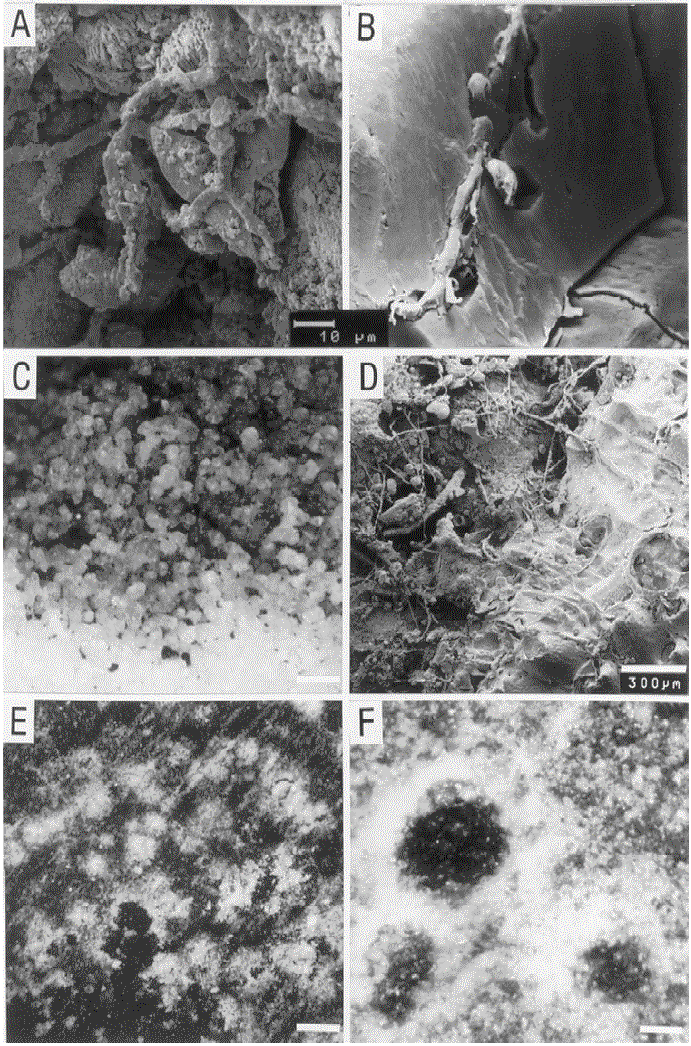Sterflinger,K.(2000): Fungi as geologic
agents. Geomicrobiology Journal, 17, 97-124.
『地質学的な作用物質としての菌類』
『(Abstract)
Although many studies on fungi and geological processes have
been published in recent years, books and congress proceedings
on geomicrobiology focus mainly on prokaryotes and algae. Therefore,
it is the aim of this review to summarize data on the fungal impact
on geological processes. These processes include the alteration
and weathering of rock and minerals, the accumulation of metals,
and the conversion of fossil organic carbon. Fossil records and
fungi in subsurface environments are also discussed. This article
especially emphasizes the role of epi- and endolithic black meristematic
fungi, discussing their deteriorative potential on rock as well
as their taxonomy and phylogeny. Moreover, the impact of fungi
on weathering of monuments and building materials is described
and new methods to study fungi-material interactions are presented.
The data summarized here show that ‘geomycology’ is a highly interesting
discipline in view of basic geological research, as well as biotechnological
application.』
『(要旨)
菌類と地質過程についての多くの研究が近年公表されているが、地球微生物学に関する著書と会議報告書は原核生物と藻類に主に焦点があっている。したがって、このレビューの目的は、地質過程に対する菌類の影響についてのデータを要約することである。これらの過程は、岩石と鉱物の変質と風化、金属の蓄積、および化石有機炭素の転化を含む。地下環境の化石記録と菌類も議論される。この論文はとりわけ、岩石の上と内部に生育する黒色の分裂組織的菌類の役割を強調し、それらの分類学と系統学だけでなく岩石に対する劣化潜在力を議論する。さらに、遺跡や建造物の風化への菌類の影響について説明し、菌類−物質相互作用を研究する新しい方法を提示する。ここで要約したデータは、生物工学的応用はもちろん基本的な地質学的研究からみて、「地球菌類学」は非常に興味深い分野であることを示している。』
(Introduction)
Fungal attack on minerals
Alteration of carbonates
Dissolution and precipitation of metal ions
Degradation of silicates
Sulfur and phosphate
Fungi as biosorbents for metal accumulation
Fungal impact on fossil organic carbon
Fossilized fungi
Mechanical forces
Sudsurface fungi
Weathering of monuments and buildings by fungal activity
Ecophysiology of epi- and endolithic meristematic fungi
Phylogeny and taxonomy of epi- and endolithic meristematic fungi
Methods for studying fungi in the geosphere
Summary
References

FIGURE 1 (A) SEM micrograph of fungal hyphae attached
to mineral particles of a sandstone surface. (B) Etching
of a calcium carbonate crystal by a fungal hyphae. (C)
Fungal growth between the crystals of quartz dissolves the carbonatic
binding matrix and results in granular disintegration (bar =
800 μm). (D) Growth margin of a self-overgrowing bryozoan
species attacked by fungal mycelium. The left side shows the
older part of the bryozoan colony being decayed by the fungi;
the right part shows the new bryozoan layer (photo: Joachim Scholz
with kind permission). (E) White fungal mycelia are attached
to a red medieval glass surface (bar = 1.5 mm). (F) Crater-shaped
lesions within the gel layer of a medieval glass surface are
caused by black fungal colonies visible in the lesions (bar =
380μm).
図1(A)砂岩表面の鉱物粒子に付着した菌糸のSEM写真。(B)菌糸による炭酸カルシウム結晶の腐食。(C)石英結晶間での菌糸の成長は、炭酸質の結合基質を溶解し、粒子状の分解を生じる(バーの長さ=800μm)。(D)菌糸に攻撃された自己増殖する苔虫類の成長縁。左側は、菌類に腐敗させられた苔虫類のコロニーの古い部分を示す;右側は、新しい苔虫類の層を示す(写真:Joachim
Scholz氏の許可による)。(E)白い菌糸体は赤色の中世のガラス表面に付着している(バー=1.5mm)。(F)中世のガラス表面のゲル層内部のクレーター形の傷は、傷内部に見える黒色菌類コロニーにより生じている(バー=380μm)。
〔『Sterflinger,K.(2000): Fungi as geologic agents. Geomicrobiology
Journal, 17, 97-124.』から〕 |
戻る
